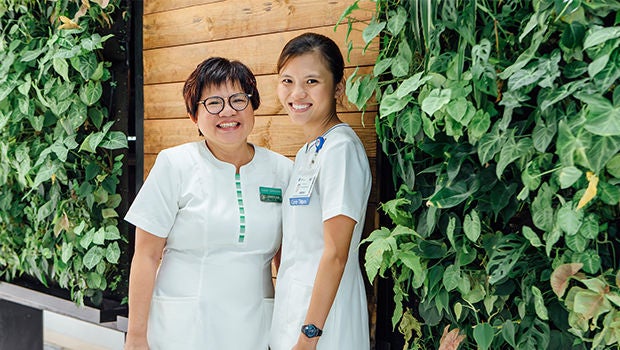
Photo: Zhaps Zhang, SPH
As we celebrate Nurses’ Day on 1 August, we take a look at how nurses who care for patients in the community ensure that they remain well-supported after their discharge.
After 95-year-old Mr Tan was discharged from a two-month stay at Changi General Hospital (CGH) for a lung and urinary tract infection, he needed to have a permanent urinary catheter fitted. His two domestic helpers were unfamiliar with catheter care, but thanks to a community nurse assigned by CGH, they were taught the practical details of catheter care.
“The nurse came to train them at our home. She was very gentle and patient with my father, and he took to her. She was a great help to us,” said Ms Estella Tan, Mr Tan’s daughter and carer.
Apart from providing training to the carers and assessing their competency, Ms Kee Mong Nee, Assistant Nurse Clinician, CGH, also monitored Mr Tan’s condition and checked whether he was taking his medication regularly, during the home visits.

Nurses like Ms Kee belong to a community care team, where nurses, doctors and allied health professionals work together to provide post-discharge care to patients in the comfort of their homes.
Many are elderly patients who have been in hospital for an extended period of at least one to two months, and need follow-up care to reduce their risk of hospital readmission. As care models in Singapore evolve to meet the needs of an ageing population, the role of nurses in the community is becoming increasingly critical.
“Patients are happier at home. I have seen many elderly patients who are sick in the wards but feel much better once they go home,” said Ms Kee, who feels that she has a special “affinity for the elderly”.
At Singapore General Hospital (SGH), Patient Navigators like Ms Deborah Tang, 59, serve a different group of patients. She cares for newly discharged elderly residents in Chin Swee Road and Banda Street.
“Being in the community allows me to serve as a bridge between health and social care, and to be a friend to these lonely residents.”
Ms Deborah Tang, Patient Navigator, SGH
“These patients live in one-room rental flats and most do not have family to rely on. They also have complex health and social issues,” said Ms Tang.
Carrying a haversack packed with blood pressure monitors, glucometer, swabs, bandages and other items which she may need, she heads to the flats to visit 10 to 15 residents every day.
She spends about 15 to 20 minutes with each resident, monitoring their health and making sure they are keeping to their medication schedules and medical appointments. Where needed, she refers them to social care and financial aid services for support. This enables vulnerable seniors to continue to live independently within the community.
Beyond providing care, these nurses give patients and their carers peace of mind. “When there is a crisis, caregivers may become frightened. This is the biggest challenge for a newly discharged patient,” said Ms Kee. She encourages carers to call her on her mobile phone.
“Patients are happier at home. I have seen many elderly patients who are sick in the wards but feel much better once they go home.”
Ms Kee Mong Nee, Assistant Nurse Clinician, CGH
“If there is a crisis or they face any difficulties, they know that they can give me a call for advice and emotional support.”
Ms Kee has more than 20 patients under her charge.
“Being in the community has added a whole new dimension to my work. It allows me to serve as a bridge between health and social care, and to be a friend to these lonely residents. Sometimes they are so happy to see me because they just want someone to talk to,” said Ms Tang, who has been a nurse for 42 years and finds her work with the elderly very rewarding.
THIS ARTICLE WAS FIRST PUBLISHED IN SINGAPORE HEALTH JULY/AUGUST 2017.













 Get it on Google Play
Get it on Google Play